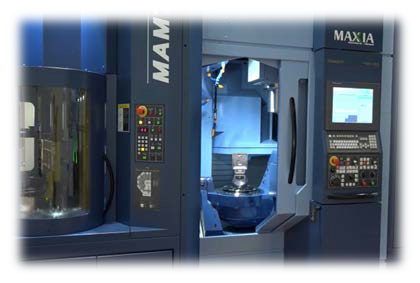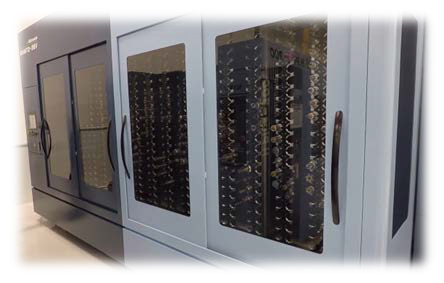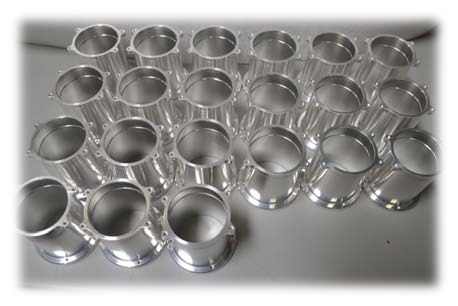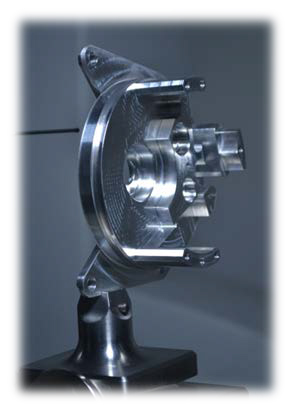Superior finishes for aerospace applications and overcoming V-flange CNC milling problems via JM Performance products’ high torque knobs.

Fairport Harbor, OH:
More than most industries, today’s aerospace, defense, and automotive component manufacturing is challenged with machining a lot of exotic alloys and hard metals. This can take a toll on the carbide cutting tools used, and the result is that the tools must be changed out more frequently as they dull or break. Tool replacement, not to mention loss of production time due to frequent changeover, can escalate costs as well.
Founded in 1978, Preco Manufacturing (Riverside, CA) has built a reputation as a leading aerospace manufacturer of precision machined components for military, government, and commercial customers around the world. A minority owned company; Preco is helmed by President, Martin Munguia, and is consistently driven by its ability to provide customers with optimal engineered parts solutions at the right cost. To fulfill this commitment, and maintain a competitive edge in the marketplace, they recently replaced all of their machines with new state-of-the art equipment to take full advantage of today’s sophisticated manufacturing technologies.
The ISO9000:2008 and AS9100 Registered Company’s goal is to control costs and provide a shorter turn around by manufacturing all phases of a component from start to finish–regardless of its critical tolerances. To achieve the result of holding tight tolerances, the company invested approximately $1.6 million in the MAM72-35V Matsuura Five Axis Machining Center (Matsuura Machinery Corporation Fukui-city, Japan)–which is synonymous with state-of-the-art unmanned (no need for operator oversight) simultaneous production for integrated close tolerances.
The MAM72-35V provides the advanced integration of a multi pallet stacker, tool carousel, and close tolerance machining center. It also features a 35 tower pallet system with and exceptionally high option of a 520 tool matrix magazine base. This robust configuration was able to meet the manufacturing challenges of Preco’s predominantly exotic material castings (stainless steel, titanium, aluminum alloys, etc.)–which creates a unique set of production machining hurdles when considering that it typically requires high speeds in excess of 20,000 RPMs. The MAM72-35V features a 20,000 RPM Hi-Tech spindle, coupled with hand built precision, which makes for an accurate and robust unattended solution for complex work like Preco’s.


In this realm of optimizing machining to its limits via hard torque, Preco was experiencing frequent broken retention knobs which resulted in costly downtime, poor finishes, and were challenging the bottom-line cost efficiencies. Additionally, they would experience excessive chatter at high RMPs because the tooling wasn’t balanced–therefore finding a solution for manufacturing high speed aluminum parts with chrome finishes at 20,000 RPMs was key.
The immediate goal for Preco was to find a “fool-proof/no-excuses” retention knob solution that wouldn’t fail! This would allow them to avoid increased costs per part, and negate impact to their ability to move toward their goal of “max-capacity/max-efficiency” aerospace manufacturing.

Imperatively, a retention knob solution had to be found to improve the contact, reduce the spindle loads, and increase the speeds and feeds–all while improving the capacity to remove more cubic inches of metal per minute. In seeking out recommendations on knobs, Preco contacted JM Performance Products, Inc. (JMPP: Fairport Harbor, OH), a leading manufacturing innovator of CNC mill spindle optimization products since 2009. The companies’ patented High Torque retention knobs were the only knobs on the market to fully address the gamut of vital and costly CNC V-Flange tooling production issues which negatively impacts tool life.
Notably, JMPP’s High Torque retention knobs are specifically designed to eliminate the toolholder expansion responsible for costly and ongoing CNC milling and boring issues. Toolholder expansion caused by standard retention knob installation can reduce the toolholder to spindle contact by 70% or more. Key to the design is a relief beneath the precision pilot that forces the threads of the knob deeper into the threaded bore of the toolholder–where a thicker cross-section of material resists the expansion and deformation.
JMPP Plant Manager, Craig Fischer, emphasized that, “Fundamentally, JMPP’s knobs also work as an integrated system that starts at the connection of the spindle and the knob. The system includes precision-cut threads which takes into account the mechanical functionality of each thread, magnetic particle testing that will reveal any faults and cracks in the material, installation torque specifications based on draw bar force and taper size, as well as replacement recommendation specifications.”

Preco was using more than 100 tools on their MAM72-35V machine so they tested a High Torque knob for every tool including drills, facemills, taps, etc. The same knobs were used across multiple tools–from a 1” reeler, 2” base mill, 32K end mill, etc.
According to Preco President, Martin Munguia, “The benefits were immediately deep and far reaching as better taper connection resulted in spindle load reduction, increased speeds and feeds, and the ability to remove more cubic inches of metal per minute. Most visibly, we were able to achieve a combination of higher quality chrome finishes on parts which is essential in aerospace/defense applications.”

Preco’s Machinist-Operator, Sam Flores, expanded on these advantages, stating, “Achieving better surface finishes also eliminates additional benching operations that add to the cycle times. We’ve had experiences with poor finishes in the past, but now we can run deep 4” bores with six finish with no taper on the end mill.”
With these empirical results in hand, Preco moved swiftly to converting all of their 5-axis machines and milling centers to JMPP’s knobs and have had them in operation for over two years. Munguia concluded that, “In the aerospace and defense industries, price is a factor, but the customer is more interested in top quality parts delivered on time. We wouldn’t dare change back to standard retention knobs.”
Flores concurred in stating, “It started with the new Matsuura machine which proved out the overall great finishes even when running heavy tools on some parts. In essence, we now exclusively use the High Torque knobs on every tool on our machines. They have better concentricity, fit exactly, and the tools perform better across the board. Most importantly, with the heavier milling we do with titanium and stainless steel parts, there are no issues with the retention knobs.”
JMPP’s Fischer surmised, “In implementing our High Torque knobs over the long haul, Preco will continue to increase speeds and feeds that deliver better cycle times to realize superior finishes and substantial savings for their demanding aerospace applications.”
For more detailed information contact: www.jmperformanceproducts.com
CORPORATE PROFILE: Established in 1966, JM Performance Products, Inc. (JMPP) has firmly established itself as a leading manufacturer of CNC mill spindle optimization products. Across a myriad of markets, JMPP is dedicated to reshoring with over 500 styles of patented Retention Knobs for BT, DIN, ISO, and CAT toolholders from 30 taper to 60 taper−all manufactured and material sourced in the United States! All products in the integrated suite are engineered to optimize milling machine performance including: improving finishes, eliminating run-out, reducing chatter and harmonics, decreasing set-up times, extending tool life, and increasing spindle performance.
Author: Craig A. Fischer / JM Performance Products, Inc. / 440.357.1234 / cfischer@jmppinc.com
Editorial & Photo Contact: Ray Farrar / Method Media LLC / 216.861.0862 / rayf@methmedia.net
©2021 JMPP. ### All rights reserved.
In this episode, I sat down with Beejan Giga, Director | Partner and Caleb Emerson, Senior Results Manager at Carpedia International. We discussed the insights behind their recent Industry Today article, “Thinking Three Moves Ahead” and together we explored how manufacturers can plan more strategically, align with their suppliers, and build the operational discipline needed to support intentional, sustainable growth. It was a conversation packed with practical perspectives on navigating a fast-changing industry landscape.